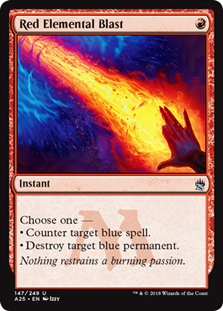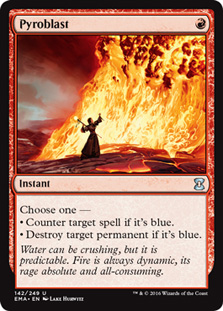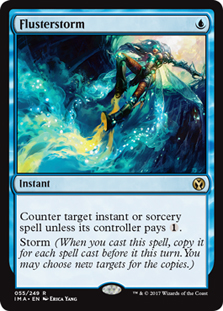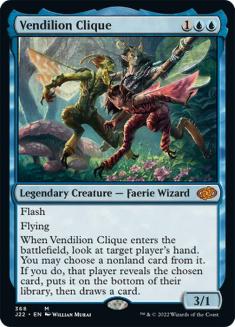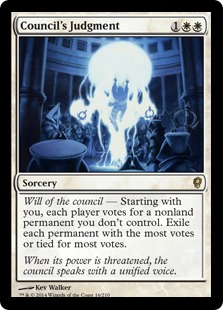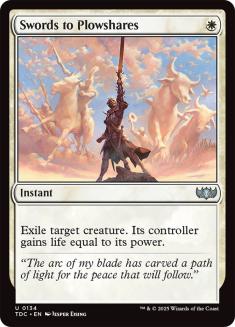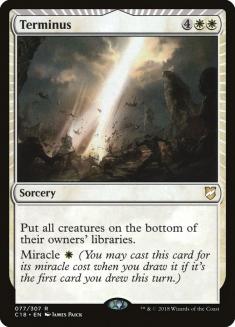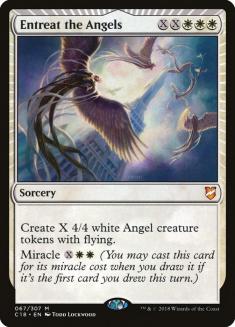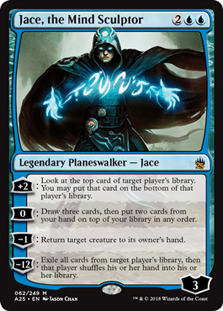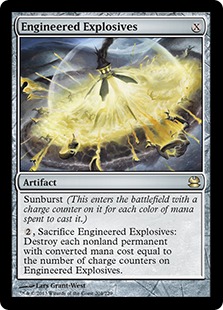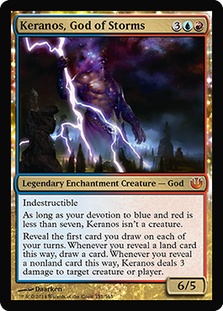Last week
, I showed you the many different ways to build Miracles as well as how to win against the various Delver decks of Legacy. This week, we’ll take a look at
how to beat the combo decks in Legacy as well as the mirror. But first, the decklist:
Creatures (3)
Planeswalkers (3)
Lands (21)
Spells (33)

In Legacy, there are two popular combo decks, one being the Show and Tell based variants and the other are decks that revolve around the Storm mechanic.
They differ greatly in pretty much every aspect. While a trained monkey could easily pilot the first one (no insult intended!), even good and experienced
players can shipwreck the other.
Let’s start with the easy one. When you sit across from an opponent with a Show and Tell based deck, the match will lose most of its strategic integrity.
What you have to do is pretty easy: counter their ways to cheat their expensive cards into play and do it efficiently. That’s it, I could very well stop
this segment here already but given the tremendous size of my paragraphs about Delver last week, I figured I should probably go a little further.
As mentioned above, your gameplan is very linear, as is theirs. Try to not let them resolve anything gamebreaking, but if they do, make sure to have that
Terminus ready. Playing as many cantrips and filter spells as possible is crucial to drawing the right half of your deck, as many cards are outright
useless in these matchups. It’s pretty hard to set up a functioning Counterbalance lock but not impossible given the right amount of time. When moving to
the sideboarded games, your approach is pretty easy too. Bring in all the disruption that you have access to, and board out the removal spells. That would
result in the following plan:
In:
Eight of the nine needed slots are pretty easy, but the ninth is once again up to your personal consideration. You could decide not to bring in the second
Council’s Judgment, which is there to deal with stuff like Pithing Needle and Defense Grid, but it can also be used to get rid of a Sneak Attack or
Emrakul, should they have made it through to the battlefield. I suggest cutting one of the win-conditions, preferably Entreat the Angels, but it could also
be Jace, the Mind Sculptor.
Out:
As mentioned above, with contrition, this match up requires far less skill on both sides than pretty much any other matchup out there and is often decided
by otherwise negligible factors such as which cards you draw in your starting seven. The preboarded matchups aren’t easy, and due to the sledgehammer
technique of their deck, it’s perfectly reasonable to lose more of them than you win. After sideboard, you should be the clear favorite here, presenting an
enormous amount of disruption which should help you win the next two games. Even though you are favored in games 2 and 3, you will probably have to win
both of them, which still isn’t all that easy as they could easily draw up an unbeatable hand. There is hardly another deck out there that can just have
these hands that control cannot deal with which is what makes Show and Tell decks so appealing.
Now let’s move to the more interesting combo deck – Storm. Storm has two major incarnations being TES (The Epic Storm) and ANT (Ad Nauseam Tendrils). The
Epic Storm is generally faster, with ANT being the slower cousin of those two, but be aware, slower is a slippery term and has practically nothing to do
with being actually slow. Both of these decks can still blow you out of the water as early as turn 1, but ANT is better equipped to play the mid- and even
the late game, whereas TES will traditionally try to murder you as quickly as possible. Their gameplan is supported by a maindeck Empty the Warrens which
allows the deck to have even more turn 1 action, but this route is not the one they want to be taking against a deck with four copies of Terminus.
Even though these decks have distinct differences, our gameplan for the first game is pretty similar: find and cast Counterbalance. No variant of Miracles
is better equipped for doing this than my version, which features a playset of Brainstorm, Sensei’s Divining Top, Ponder, and Counterbalance. You hardly
stand a chance in the preboarded games without this lovely enchantment though you could try to float a Force of Will on top of your library with Sensei’s
Divnining Top in play, which is generally a good idea against ANT but is lackluster when facing The Epic Storm due to Silence being part of their
disruption suite.
Both versions of Storm will bring some kind of disruptive or annoying creature to the sideboarded games. Expect Xantid Swarm from TES and sometimes Young
Pyromancer from ANT, but don’t be surprised when you run into a Storm opponent bringing in Dark Confidant as well. This is why you have to keep some
removal in your deck after sideboard, but which spell is the big question. Swords to Plowshares is obviously better against Xantid Swarm and Dark Confidant
but somewhat lackluster against Young Pyromancer and the occasional Burning Wish for Empty the Warrens after the coast is clear. There are valid points to
be made for keeping Swords to Plowshares in even if you’re not afraid of Young Pyromancer and I think it’s better not to be afraid of Young Pyromancer too
much, so I prefer to keep Swords to Plowshares against ANT and Terminus against TES. That leads to these two sideboarding plans, but as I mentioned above,
I could certainly see you switching up the removal spells here and there:
Out vs ANT:
In vs ANT:
Out vs TES:
In vs TES:
Matches against Storm are always of great enjoyment to both players, given each of them knows what to do, as they open a variety of opportunities for tight
play, creative sideboarding, and lots of bluffing. You have to be aware of how blazingly fast Storm decks can be, especially TES, but never underestimate
ANT’s ability to go for the long game, as they have access to Past in Flames in combination with powerful ritual spells like Cabal Ritual to make sure that
they can keep up with you (that’s why I bring in Rest in Peace against them).
Another very important factor that influences this matchup is the weight that is put on mana cost. As the fundamental turn of this matchup is pretty early,
being able to interact as fast as possible is very important. This principle doesn’t only apply to the early game but also translates to the mid game as
well. It’s rather important to lower the mana cost of your interactive spells as far as you can, but this has probably already happened in the deckbuilding
process.
Vendilion Clique, for example, does not only act as a Sulfur Elemental which pitches to Force of Will, but also provides you with a type of disruption that
is something a UWR Delver deck always lacks–hand disruption. Many people refer to Clique as a Duress with flash, but this card is more and less at once.
It’s pretty obvious, but Vendilion Clique only lets you cycle one of their cards, and even though this might often be as good as making them discard the
spell, there are times when it isn’t. One can play around this effect with various ways of smart cantripping, not to mention that this effect can easily be
negated by pure luck. This increased value of variance is something to be aware of, as you can tap out in their draw step to strip their only Infernal
Tutor with Clique only to die anyways because they drew another one, all while you stare at those counterspells in your hand. Even though Vendilion Clique
is phenomenal in the matchup, it is important to calculate this very downside by exercising patient play, and that means not slamming it on the third turn
as soon as they draw a card.
Take your time.
While patience is an overly valuable tool in most matches, it’s especially important here, as tapping out at the wrong moment can lead to a cruel and
disheartening defeat. Matches like this tend to have a lot of very important decisions in a small amount of turns, compared to the more general way of
playing Miracles, which equals having many, though not so important, decisions over a large amount of turns.
If you don’t play my exact list, think about cutting your 22nd land in this matchup (assuming you’re playing 22). I used to cut the second Plains in this
matchup when I played more lands and felt like sharing this information, even though this isn’t really associated with my most recent list. And while I’m
at it, why don’t we talk a bit about the importance of mana in this matchup? The twist in this matchup lies in the fact that you should be using all your
mana every single turn, but you also shouldn’t be tapping your lands, due to the fact that you should be keeping up your wall of protection. This wouldn’t
be a problem if our deck was constructed the way Modern UWR Control variants are, but contrary to common belief, Miracles is not a Draw-Go Deck, at least
not in its purest form. Cards like Ponder, Sensei’s Divnining Top, and Counterbalance are incredibly important in this matchup but also very tough to play
due to their sorcery speed. Think about casting these cards a little more than you’re used to.
The last matchup I want to touch on is a very important one. Being able to have good percentages against all of the field is not enough if you are not
somewhat prepared to deal with the mirror. Some of the branches I discussed last week certainly have upsides in the mirror match, but the version I’m
currently playing isn’t the best against other versions of Miracles because It sacrifices the ability to constantly interact with the stack (no Spell
Pierce and Vendilion Clique) for the upside of finding Counterbalance with more regularity. As the pre-sideboarded game of the mirror often revolves around
avoiding the white half of your deck, I believe my approach to Miracles is pretty good. While you won’t be able to compete with any of the other branches
as long as they draw the right half of their deck, it is way more likely that my four Ponder and four Counterbalance version gets the lock in place before
the opponent which can be good enough to steal the game. These matches revolve a little bit too much around variance for my tastes, as your starting seven
play a great deal into your ability to interact with pretty much anything. If you keep a removal heavy hand and your opponent leads with Sensei’s Divining
Top, you’re in a world of trouble.
There are two basic approaches to the mirror. The first one revolves around getting Counterbalance in play, which can grant you some virtual card
advantage, which is dearly needed in a showdown that is characterized by countless dead cards. This approach has the problem of being pretty susceptible to
an Entreat the Angels, as you cannot possible counter it with your Counterbalance. The more general approach, which also includes dropping Counterbalance
at some point, is resolving Jace, the Mind Sculptor. The difficult thing about this, however, is finding the right time to cast the planeswalker while not
letting theirs resolve.
When it comes to sideboarding, it’s pretty easy: bring out as many useless white spells as you can in order to up your count of blue and red cards. Yet it
isn’t as easy as it seems at first, as the possible approaches are quite different:
Out:
In:
This approach tries to fight over everything on the stack, having only two Explosives to deal with Counterbalances or Entreat the Angels tokens. There are
literally no white cards in the deck anymore, making it practically impossible to draw anything that isn’t going to help in one way or another.
The second way to approach this matchup is a little different and focuses more on the permanents that will be slipping through, regardless of your efforts.
Out:
In:
This approach tries to have at least four ways to deal with stuff that has resolved, two of which are Engineered Explosives again, the other two being
either two Council’s Judgment or a Judgment and a Disenchant.
Both variants are valid branches from the general approach of not wanting white cards. One thing that might stick out is the absence of Entreat the Angels
after sideboard, and you might be disagreeing. I’m a strong proponent of not keeping a card as unreliable and difficult to set up as Entreat the Angels in
a match that is so much about mirroring your opponent’s plays by creating crucial advantage due to a superior deck and a lower count of lands. Drawing more
immediate business is key here; not the option to have an I-win button later in the game which is very likely to be countered by one of the taxing counters
that have been stuck in your opponent’s hand.
That said, I can see the upsides of keeping Entreat the Angels in sideboarded games. Having ways to win the game from a gamestate where you shouldn’t be
winning anymore is huge, but it comes with a price. I have too often lost against competent opponents deploying Engineered Explosives on zero in advance,
leaving me not only with bad cards in my deck, but more importantly, with a hugely screwed up sequence, which lead to me playing to this very out,
resulting in a number of bad choices. Of course, your opponent can get lucky and just find the one-of Entreat in the last possible turn, but I am fine with
losing to that, as variance is part of the game but shouldn’t be incorporated too heavily into your plan, after all.
The same principles as the ones mentioned above about the pre-board games apply to the sideboarded ones, but even more so, because there’s hardly any
reason to rush out your cards. You have to be patient, and you have to wait and hope that your opponent will make the first step. Additionally, you have
the trump that is Keranos, God of Storms, a card that is not beatable once resolved with the lone exception of Entreat the Angels (but this card shouldn’t
be in their deck anyways). Another big factor in the mirror match are the flash creatures, which are extremely valuable due to their ability to pressure
Jace. Besides, who would want to cast Red Elemental Blast on a Snapcaster Mage that was used to Flashback a Ponder?
Countering Sensei’s Divning Top is both crucial and unnecessary. Should you have the option to deal with it in the early game, do so, but do not use your
Force of Will on the Top. No matter how important this card is for Miracles, you will risk dying to a Jace, the Mind Sculptor being deployed on their
fourth turn, with you having hardly any cards in your hand.
There is no need to delay your defeat. This is extremely important for the mirror as it is a very time-consuming matchup. Do not waste another ten minutes
to find your one card that might win you the game. Simply concede and head to the next game so that you have enough time to finish it.
The mirror matches are very enjoyable, and even though the pre-boarded games are variance laden, the postboard ones make up for it. It is yet again very
similar to Storm, a game of patience as well as casting your cantrips right while also stacking the top of your deck in the correct manner, all the while
maintaining a certain amount of speed. Once you get used to playing the mirror you will love it!
Or hate it forever.

